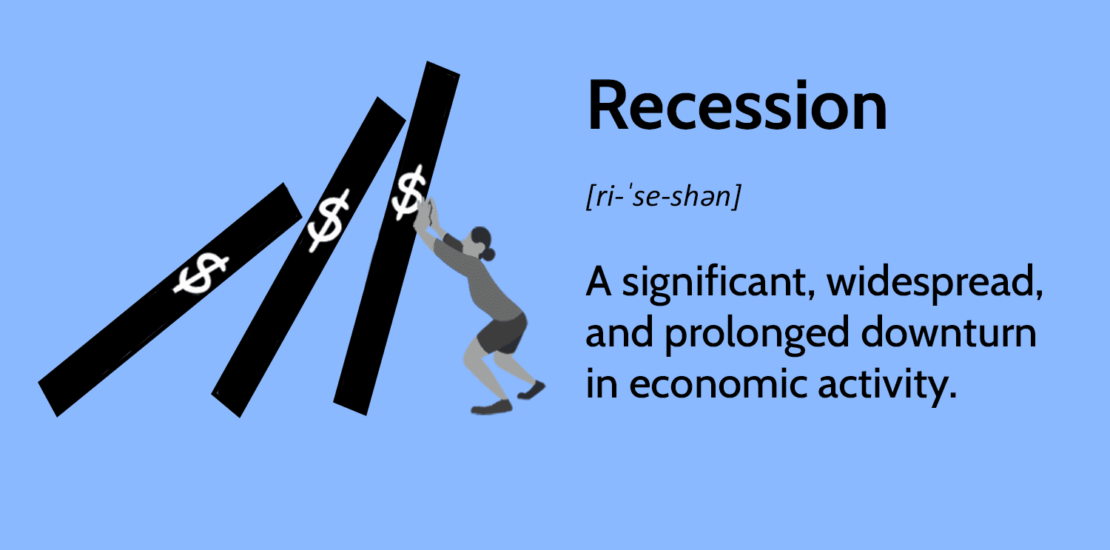- December 28, 2022
- Posted by: World Skills Institute™
- Category: Uncategorized

What Is a Recession?
:max_bytes(150000):strip_icc():format(webp)/recession-ad4ab2ce01604953a1b4f939ebaaa40c.png)
A recession is a significant, widespread, and prolonged downturn in economic activity. A common rule of thumb is that two consecutive quarters of negative gross domestic product (GDP) growth mean recession, although more complex formulas are also used.
Economists at the National Bureau of Economic Research (NBER) measure recessions by looking at nonfarm payrolls, industrial production, and retail sales, among other indicators, going far beyond the simpler (although not as accurate) two quarters of negative GDP measure.1
However, the NBER also says there is “no fixed rule about what measures contribute information to the process or how they are weighted in our decisions.”
KEY TAKEAWAYS
- A recession is a significant, pervasive, and persistent decline in economic activity.
- Economists measure a recession’s length from the prior expansion’s peak to the downturn’s trough.
- Recessions may last as little as a few months, but the economy may not recover to its former peak for years.
- An inverted yield curve has predicted the last 10 recessions, although some predicted recessions never materialized.
- Unemployment often remains high well into an economic recovery, so the early stages of a rebound can feel like a continuing recession for many.
- Nations use fiscal and monetary policies to limit the risks of a recession.
A downturn must be deep, pervasive, and lasting to qualify as a recession by the NBER’s definition, but these calls come after the fact: It is not a clear formula to identify a recession as soon as one begins.2
Understanding Recessions
Since the Industrial Revolution, most economies have grown steadily and economic contractions are an exception, although recessions are still common. Between 1960 and 2007, there were 122 recessions that affected 21 advanced economies roughly 10% of the time, according to the International Monetary Fund (IMF).5
In recent years, recessions have become less frequent and don’t last as long.
The declines in economic output and employment that recessions cause can become self-perpetuating. For example, declining consumer demand can prompt companies to lay off staff, which affects consumer spending power, which can further weaken consumer demand.
Similarly, the bear markets that often accompany recessions can reverse the wealth effect, suddenly making people less wealthy and further trimming consumption.
Since the Great Depression, governments around the world have adopted fiscal and monetary policies to prevent a run-of-the-mill recession from becoming far worse.67 Some of these stabilizing factors are automatic, such as unemployment insurance that puts money into the pockets of employees who lost their jobs. Other measures require specific actions, such as cutting interest rates to stimulate investment.
Recessions are usually clearly identified only after they are over. Investors, economists, and employees may also have very different experiences in terms of when a recession is at its worst.
Equities markets often decline before an economic downturn, so investors may assume a recession has begun as investment losses accumulate and corporate earnings decline, even if other measures of recession remain healthy, such as consumer spending and unemployment.
Conversely, since unemployment often remains high long after the economy hits bottom, workers may perceive a recession as continuing for months or even years after economic activity recovers.
What Predicts a Recession?
While there is no single, sure-fire predictor of recession, an inverted yield curve has come before each of the 10 U.S. recessions since 1955, although not every period of inverted yield curve was followed by recession.8
When the yield curve is normal, short term yields are lower than long term yields. This is because longer-term debt has more duration risk. For example, a 10-year bond usually yields more than a 2-year bond as the investor is taking a risk that future inflation or higher interest rates could lower the bond’s value before it can be redeemed. So, in this case the yield goes up over time, creating an upward yield curve.
The yield curve inverts if yields on longer-dated bonds go down while yields on shorter term bonds go up. The rise of near term interest rates can tip the economy into a recession. The reason why the yield on long term bonds drops below that on short term bonds is because traders anticipate near term economic weakness leading to eventual interest rate cuts.
Investors also look at a variety of leading indicators to predict recession. These include the ISM Purchasing Managers Index, the Conference Board Leading Economic Index, and the OECD Composite Leading Indicator.
What Causes Recessions?
Numerous economic theories attempt to explain why and how an economy goes into recession. These theories can be broadly categorized as economic, financial, psychological, or a combination of these factors.
Some economists focus on economic changes, including structural shifts in industries, as most important. For example, a sharp, sustained surge in oil prices can raise costs across the economy, leading to recession.
Some theories say financial factors cause recessions. These theories focus on credit growth and the accumulation of financial risks during good economic times, the contraction of credit and money supply when recession starts, or both. Monetarism, which says recessions are caused by insufficient growth in money supply, is a good example of this type of theory.
Other theories focus on psychological factors, such as over-exuberance during economic booms and deep pessimism during downturns to explain why recessions occur and persist. Keynesian economics focuses on the psychological and economic factors that can reinforce and prolong recessions. The concept of a Minsky Moment, named for economist Hyman Minsky, combines the two to explain how bull-market euphoria can encourage unsustainable speculation.
Recessions and Depressions
According to the NBER, the U.S. has experienced 34 recessions since 1854, but only five since 1980.9 The downturn following the 2008 global financial crisis and the double-dip slumps of the early 1980s were the worst since the Great Depression and the 1937-38 recession.
Routine recessions can cause the GDP to decline 2%, while severe ones might set an economy back 5%, according to the IMF. A depression is a particularly deep and long-lasting recession, though there is no commonly accepted formula to define one.
During the Great Depression, U.S. economic output fell 33%, stocks plunged 80%, and unemployment hit 25%.10 During the 1937-38 recession, real GDP fell 10% while unemployment jumped to 20%.11
Recent Recessions
The 2020 COVID-19 pandemic and the public health restrictions imposed to stop it are an example of an economic shock that can cause recession. The depth and widespread nature of the economic downturn caused by the COVID-19 pandemic in 2020 led the NBER to designate it a recession despite its relatively brief two-month length.4
In 2022, many economic analysts debated whether the U.S. economy was in recession or not, given that some economic indicators pointed to recession, but others did not.
Analysts with investment advisory firm Raymond James argued in an October 2022 report that the U.S. economy was not in recession. The investment advisor argues that the economy did meet the technical definition of recession after two consecutive quarters of negative growth, but that numerous other positive economic indicators show the economy is not in recession.
First, it cites the fact that employment continued to increase even though GDP contracted. The report further points out that although real personal disposable income also declined in 2022, much of the decline was a result of the end of COVID-19 relief stimulus, and that personal income excluding these payments continued to rise.12
Data from the The Federal Reserve Bank of St Louis as of late October 2022 similarly show that key NBER indicators do not point to the U.S. economy being in recession.13
Frequently Asked Questions
What Happens in a Recession?
Economic output, employment, and consumer spending drop in a recession. Interest rates are also likely to decline as the central bank (such as the U.S. Federal Reserve Bank) cuts rates to support the economy. The government’s budget deficit widens as tax revenues decline, while spending on unemployment insurance and other social programs rises.
When Was the Last Recession?
The last U.S. recession was in 2020, at the outset of the COVID-19 pandemic. According to NBER, the two-month downturn ended in April 2020, qualifying as a recession as it was deep and pervasive despite its record short length.4
How Long Do Recessions Last?
The average U.S. recession since 1857 lasted 17 months, although the six recessions since 1980 averaged less than 10 months.9
The Bottom Line
A recession is a significant, widespread, and prolonged downturn in economic activity. A common rule of thumb is that two consecutive quarters of negative gross domestic product (GDP) growth mean recession, but many use more complex measures to decide if the economy is in recession.
Unemployment is one key feature of recessions. As demand for goods and services falls, companies need fewer workers and may lay off staff to cut costs. Laid off staff have to cut their own spending, which in turn hurts demand, which can lead to more layoffs.
Since the Great Depression, governments around the world have adopted fiscal and monetary policies to prevent a run-of-the-mill recession from becoming worse.67 Some are automatic, such as unemployment insurance to put money into the pockets of employees who lost their jobs. Other measures require specific action, such as cutting interest rates to stimulate investment.1
In recent years, recessions have become less frequent and don’t last as long.
While there is no single, sure-fire predictor of recession, an inverted yield curve has come before each of the 10 U.S. recessions since 1955, although not every period of the yield curve inverting was followed by recession.8
Finding the right financial advisor that fits your needs doesn’t have to be hard. SmartAsset’s free tool matches you with fiduciary financial advisors in your area in 5 minutes. Each advisor has been vetted by SmartAsset and is legally bound to act in your best interests. If you’re ready to be matched with local advisors that will help you achieve your financial goals, get started now.
